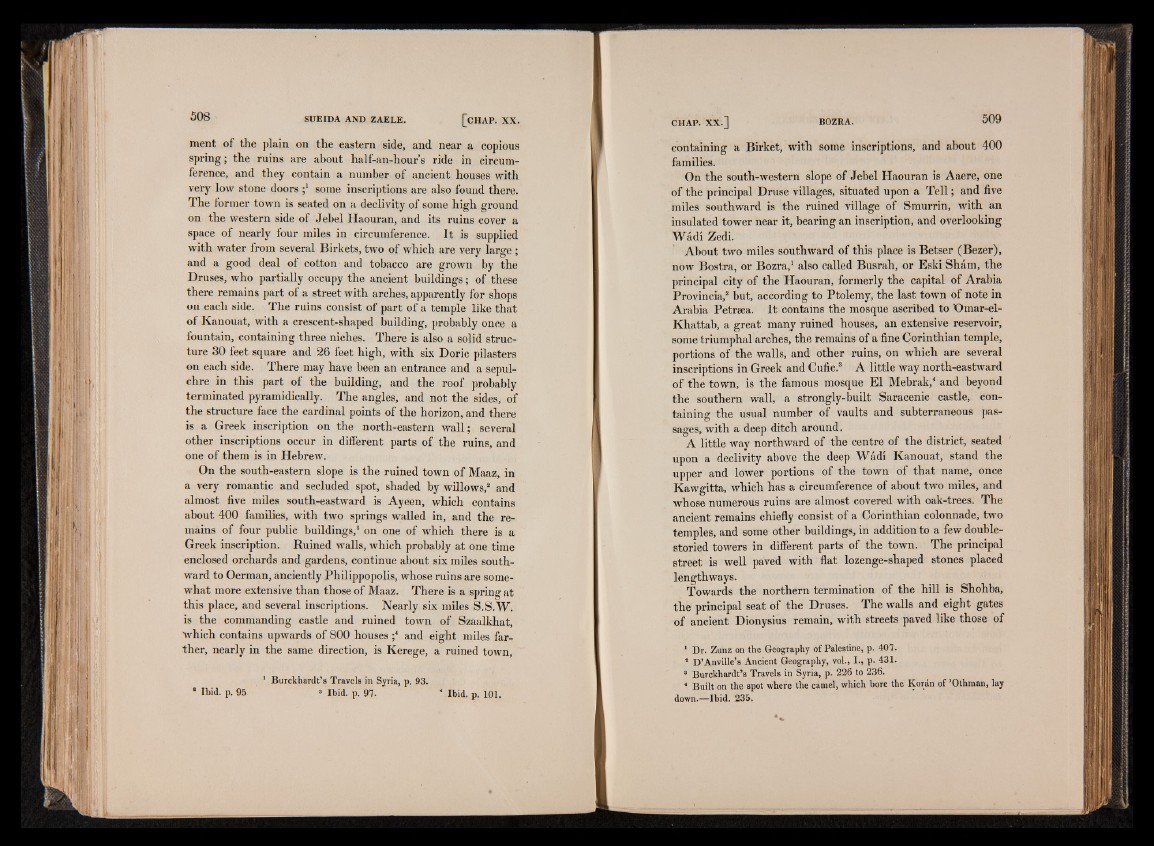
ment of the plain on the eastern side, and near a copious
spring; the ruins are about half-an-hour’s ride in circumference,
and they contain a number of ancient houses with
very low stone doors some inscriptions are also found there.
The former town is seated on a declivity of some high ground
on the western side of Jebel Haouran, and its ruins cover a
space of nearly four miles in circumference. It is supplied
with water from several Birkets, two of which are very large ;
and a good deal of cotton and tobacco are grown by the
Druses, who partially occupy the ancient buildings; of these
there remains part of a street with arches, apparently for shops
on each side. The ruins consist of part of a temple like that
of Kanouat, with a crescent-shaped building, probably once a
fountain, containing three niches. There is also a solid structure
30 feet square and 26 feet high, with six Doric pilasters
on each side. There may have been an entrance and a sepulchre
in this part of the building, and the roof probably
terminated pyramidically. The angles, and not the sides, of
the structure face the cardinal points of the horizon, and there
is a Greek inscription on the north-eastern wall; several
other inscriptions occur in different parts of the ruins, and
one of them is in Hebrew.
On the south-eastern slope is the ruined town of Maaz, in
a very romantic and secluded spot, shaded by willows,8 and
almost five miles south-eastward is Ayeen, which contains
about 400 families, with two springs walled in, and the remains
of four public buildings,3 on one of which there is a
Greek inscription. Ruined walls, which probably at one time
enclosed orchards and gardens, continue about six miles southward
to Oerman, anciently Philippopolis, whose ruins are somewhat
more extensive than those of Maaz. There is a spring at
this place, and several inscriptions. Nearly six miles S.S.W.
is the commanding castle and ruined town of Szaalkhat,
which contains upwards of 800 houses ;4 and eight miles farther,
nearly in the same direction, is Kerege, a ruined town,
1 Burckhardt’s Travels in Syria, p. 93.
* Ibid. p. 95 • Ibid. p. 97. 4 Ibid. p. 101.
containing a Birket, with some inscriptions, and about 400
families.
On the south-western slope of Jebel Haouran is Aaere, one
of the principal Druse villages, situated upon a Tell; and five
miles southward is the ruined village of Smurrin, with an
insulated tower near it, bearing an inscription, and overlooking
Wadi Zedi.
About two miles southward of this place is Betser (Bezer),
now Bostra, or Bozra,1 also called Busrah, or Eski Sham, the
principal city of the Haouran, formerly the capital of Arabia
Provincia,8 but, according to Ptolemy, the last town of note in
Arabia Petrsea. It contains the mosque ascribed to ’Omar-el-
Khattab, a great many ruined houses, an extensive reservoir,
some triumphal arches, the remains of a fine Corinthian temple,
portions of the walls, and other ruins, on which are several
inscriptions in Greek and Cufic.3 A little way north-eastward
of the town, is the famous mosque El Mebrak,4 and beyond
the southern wall, a strongly-built Saracenic castle, containing
the usual number of vaults and subterraneous passages,
with a deep ditch around.
A little way northward of the centre of the district, seated
upon a declivity above the deep Wadi Kanouat, stand the
upper and lower portions of the town of that name, once
Kawgitta, which has a circumference of about two miles, and
whose numerous ruins are almost covered with oak-trees. The
ancient remains chiefly consist of a Corinthian colonnade, two
temples, and some other buildings, in addition to a few double-
storied towers in different parts of the town. The principal
street is well paved with flat lozenge-shaped stones placed
lengthways.
Towards the northern termination of the hill is Shohba,
the principal seat of the Druses. The walls and eight gates
of ancient Dionysius remain, with streets paved like those of
1 Dr. Zunz on the Geography of Palestine, p. 407.
s D’Anville’s Ancient Geography, vol., I., p. 431.
s Burckhardt’s Travels in Syria, p. 226 to 236.
4 Built on the spot where the camel, which bore the Koran of ’Othman, lay
down.—Ibid. 235.